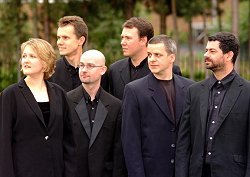The Keys to the Future festival, at Greenwich House’s Renee Weiler Concert Hall, presents 3 consecutive nights of recent solo piano music – each concert has 4 pianists. The fundamental premise of this festival is that the contemporary scene is characterized by unprecedented diversity, and that that is a good thing. Each of the 3 evenings presents some strange juxtapositions of styles – sometimes the only thing that two pieces on one of our programs have in common is that they are notated and contemporary. I prefer this to a concert of works all in the same style – when a post-minimalist work follows an atonal modernist work on the same program, they tend to highlight characteristics in each other in interesting and unexpected ways. Audiences have really responded to this aspect of the shows.
A few words about a couple of the pieces. On Evening 1, Marina Lomazov, Blair McMillen, Tatjana Rankovich and I will play works of Louis Andriessen, Poul Ruders, Joan Tower, John Fitz Rogers, Joseph Rubenstein and Henry Martin. Andriessen’s “The Memory of Roses” presents a particularly intimate and personal side of the composer’s work. Over the last 4 decades, Andriessen has written short pieces for family and friends, often performed at birthdays. He decided to collect 20 of these pieces, and I will be playing the 7 of these works that are for solo piano. These are very small-scale charming works with all kinds of stylistic influences, from Chopin and Chabrier to Stravinsky and Cage. Speaking of the latter, one of these short works (“Chorale”) was written and completed the day John Cage died and is a moving tribute. There is another piece that can be played on music box or piano (I’ll play it on piano), that uses exclusively the highest register of the piano, to beautiful effect.
Closing Evening 1, the phenomenal virtuoso and new music champion Tatjana Rankovich will play 4 Preludes and Fugues by Henry Martin. Henry has composed Preludes and Fugues in each key – obviously, they look back to Bach but they are also firmly rooted in the present – particularly the Preludes, but even the Fugues manage to sound contemporary. (This is not easy to do.) There isn’t any way to pigeonhole these pieces – neo-Baroque and neo-Romantic both apply to some extent, but none capture the totality of the music. The final Prelude and Fugue, in one movement and subtitled “A Slow Drag,” is a technical tour de force and a lot of fun – it closes Opening Night of our little festival down at Greeenwich House.
The Rogers “Variations” is a monumental neo-Romantic work of ‘face-melting’ virtuosity – Marina plays the hell out of it. Tower’s “Throbbing Still” is aggressive and viscerally powerful, and Blair plays the hell out of it. The Ruders has minimalist and jazz influences. My “Romance No. 2 (aurora)” is a flowing, hybrid work in which I express my love for the instrument. For more info, please check our website www.keystothefuture.org. Hope to see you at the shows! I’ll write some more notes tomorrow about Evening 2.
Joseph Rubenstein
Artistic Director, Keys to the Future
 (OK, OK I know, the puns don’t come any worse than that…) No F.Z. music, but rather a reminder that The excellent U.K. ensemble Psappha (with help from Lancaster University and the BBC Singers) is in the middle of a
(OK, OK I know, the puns don’t come any worse than that…) No F.Z. music, but rather a reminder that The excellent U.K. ensemble Psappha (with help from Lancaster University and the BBC Singers) is in the middle of a 
